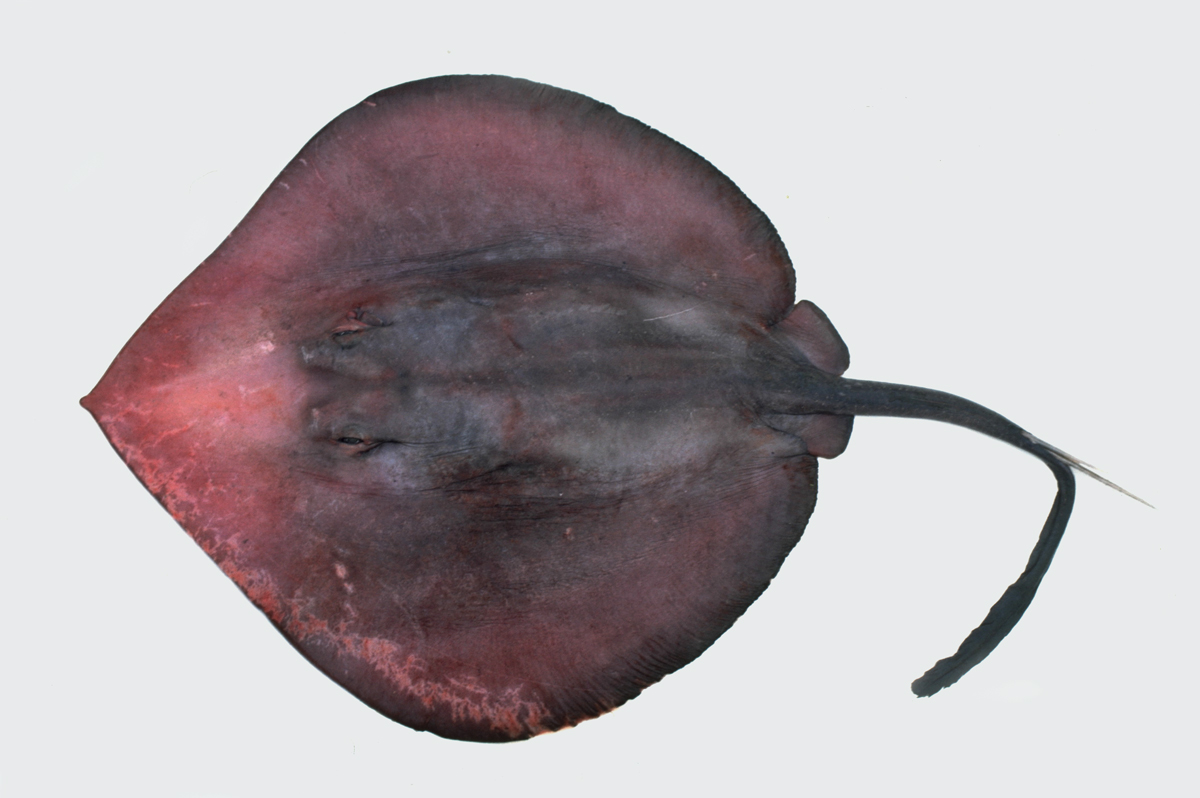Giant Stingaree, Plesiobatis daviesi (Wallace 1967)
Other Names: Deepwater Stingray

A Giant Stingaree, Plesiobatis daviesi. Source: Ken Graham / NSW Fisheries. License: CC by Attribution-NonCommercial-ShareAlike
Summary:
A large greyish-black to brownish or purplish-brown stingray with a black margin on the disc, a white underside, rear edges of the pelvic fins and tail grey, and a pale sting. This is the largest stingray and it occurs in deeper waters than any other species.
Cite this page as:
Bray, D.J. 2017, Plesiobatis daviesi in Fishes of Australia, accessed 01 Jul 2025, https://fishesofaustralia.net.au/Home/species/3002
Giant Stingaree, Plesiobatis daviesi (Wallace 1967)
More Info
|
Distribution |
Off Shark Bay to Rowley Shoals, Western Australia, and from off Townsville, Queensland, to off Wooli, New South Wales. Elsewhere the species has a sporadic and patchy distribution in the Indo-west-central Pacific. It is demersal on the continental slope at depths of 275–680 m. |
|
Features |
A giant plain stingray with a broadly pointed snout, small eyes and a round disc; tail short with a long caudal fin and a narrow sting; upper surface covered with denticles. |
|
Feeding |
Feeds on small pelagic fishes, eels, crabs, shrimp, lobsters, cephalopods and polychaete worms. |
|
Etymology |
The species is named daviesi in honour of David H. Davies, a former director of the Ocean Research Institute, Durban, South Africa. |
|
Species Citation |
Urotrygon daviesi Wallace 1967, Investigational Report. Oceanographical Research Institute, Durban 16: 8, figs 3-4. Type locality: Mozambique Channel, off mouth of Limpopo River, South Africa. |
|
Author |
Bray, D.J. 2017 |
|
Resources |
Giant Stingaree, Plesiobatis daviesi (Wallace 1967)
References
Compagno, L.J.V. & Last, P.R. 1999. Family Plesiobatidae. pp. 1467-1468 in Carpenter, K.E. & Niem, V.H. (eds). The Living Marine Resources of the Western Central Pacific. FAO Species Identification Guide for Fisheries Purposes. Rome : FAO Vol. 3 pp. 1397-2068.
Ebert, D.A., Cowley, P.D. and Compagno, L.J.V. 2002. First records of the longnose spiny dogfish Squalus blainvillei (Squalidae) and the deep-water stingray Plesiobatis daviesi(Urolophidae) from South African waters. South African Journal of Marine Science 24: 355-367.
Gloerfelt-Tarp, T. & Kailola, P.J. 1984. Trawled Fishes of Southern Indonesia and Northwest Australia. Jakarta : Dir. Gen. Fish. (Indonesia), German Tech. Coop., Aust. Dev. Ass. Bur. 406 pp.
Last, P.R. & Stevens, J.D. 1994. Sharks and Rays of Australia. Canberra : CSIRO Australia 513 pp. 84 pls.
Last, P.R. & Stevens, J.D. 2009. Sharks and Rays of Australia. Collingwood : CSIRO Publishing Australia 2, 550 pp.
Nishida, K. 1990. Phylogeny of the suborder Myliobatidoidei. Memoirs of the Faculty of Fisheries, Hokkaido University 37(1-2): 1-108.
Séret, B. & Last, P.R. 2016. 28. Giant Stingarees. Family Plesiobatidae, pp. 674-675. In: Last, P.R., White, W.T., Carvalho, M.R. de, Séret, B., Stehmann, M.F.W. & Naylor, G.J.P. (eds) Rays of the World. Clayton South, Victoria : CSIRO Publishing 790 pp.
Wallace, J.H. 1967. The batoid fishes of the east coast of southern Africa. Part 2: manta, eagle, duckbill, cownose, butterfly and sting rays. Investigational Report. Oceanographical Research Institute, Durban 16: 1-56.
White, W.T., Kyne, P.M. & Holtzhausen, H. 2015. Plesiobatis daviesi. The IUCN Red List of Threatened Species 2015: e.T60111A68640813. http://dx.doi.org/10.2305/IUCN.UK.2015-4.RLTS.T60111A68640813.en. Downloaded on 10 July 2017.



